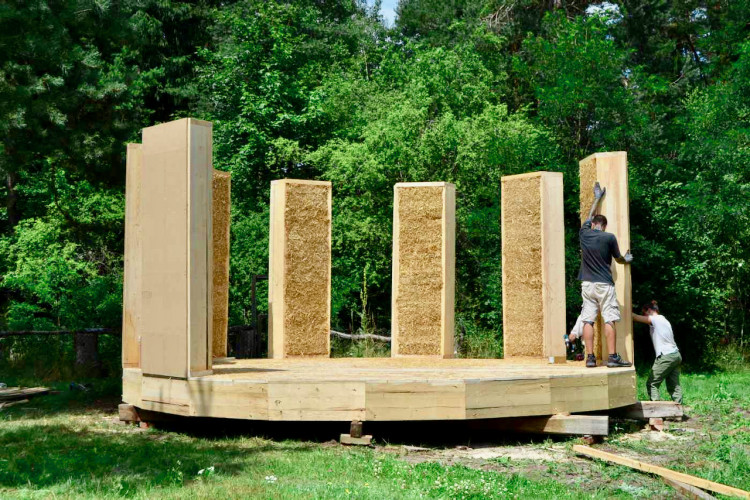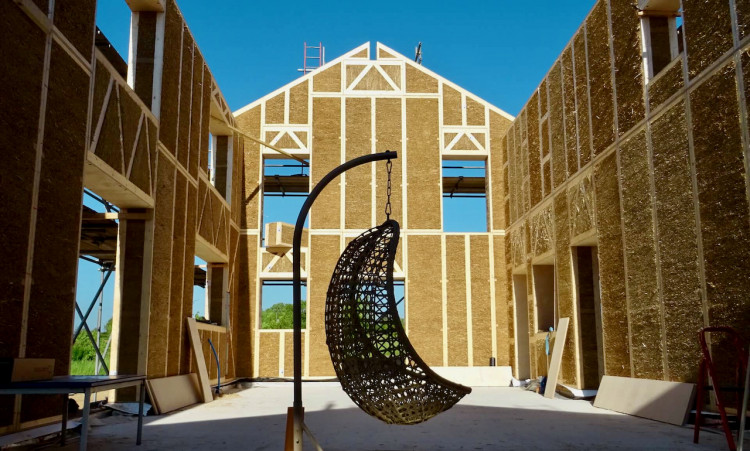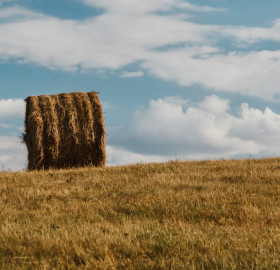EcoCocon presented at this year’s European Straw Building Gathering 2021, a 3-day event with practical workshops, presentations and tours, which took place simultaneously in several European countries, July 30th - August 1st.
The perfect opportunity to interview Herbert Gruber, organiser of this year’s ESBG, to get him to reflect on more than 20 years of the conference.
In this interview, you will learn:
- The origins of the ESBG
- What we learned about straw bale in 20+ years
- The future of straw bale building
- How natural fibres can beautify our cities
How did you get started in straw bale and ecological building?
In 1999 we had an ecological magazine in Vienna about eco-building, and had an invite from an architect in Vienna called Günther Höchtl, who’d built a small temporary straw house in Plank am Kamp.
It was a landscape art project, so not a real house, built with bales and a glass facade. I saw these bales and I thought this was a good idea, one I’d never heard of in all my time in natural building.
So I went to the library in Vienna and found this book from Athena Steen and David Bainbridge and was fascinated. We talked with other friends from the association, and then it was one step after another. We presented a conference, wrote a book out of the study, and made a company called StrohTec.
We founded ASBN (the Austrian Strawbale Network) and the first houses in Austria were built 21 years ago.
How did the ESBG itself get started?
The idea of this gathering was born in 1998 by Martin Oehlmann, a Dutch straw bale builder. The second, organised by Lars Keller and Harald Wedig, was in Denmark and with the support of Matts Myhrman and David Eisenberg from the USA they helped establish a European gathering. One year it’s international and one year is European, which is why it’s biannual.
At the third ESBG in Austria, 2002, there was this old guard of straw bale builders, Werner Schmidt, Martin Oehlmann, Dick Scharmer, who still exist, but a lot of young, motivated people can now take over.
What we added in the 20 years of ESBG is that you can enjoy it and not just learn! There is a lot of knowledge in a more or less entertaining way, and there are people you already know and see again, a moment for the heart.
How did you end up responsible for the ESBG?
As the ESBG is virtual this year, and many organisations have difficulties dealing with the technical things, I took on the responsibility - without realising I had to take on the whole organisation. But times change and after COVID, with the big projects like UP STRAW, people had less and less time. Though, I also have my weaknesses!
In Todmorden, 2019, at the last ESBG, we decided that the next ESBG should be a united one - half-virtual, with real workshops in the member countries, and this was thought up before the outbreak of Coronavirus, which we couldn’t have foreseen.
It was somehow perfect to make this combination now. With 200-300 straw bale people coming, we wanted a little bit more. And we wanted to reach a bigger audience in these times of climate change and make an impact, with a good program, with videos which stay online. This is a huge step, and also a step for all the member countries, plus we are now used to virtual conferences.
Coronavirus will stop but climate issues won’t, so this is a real possibility to have a small answer to climate change, specifically to primary energy content and problems in the building industry.
What are your personal highlights over the 20 years history of the gathering?
Well, there are the stars like the architect, Werner Schmidt. In each house he tries something new. Every two years you hear a completely new story about his trials. When wood is more expensive, to see a load-bearing roof made is a special study.
What else we have seen over the years is quite an alternative scene - self-builders and hobbit houses like Simon Dale’s - at that time it was a technique associated with cheap building.
Over time there evolved a lot of systems which could be built in urban areas. We tried it for the first time in France in Montargis with ESBG: the title was “Straw Goes Urban” and this was the time when we first saw the 7-storey building in Saint Dié, France, and also the 5-storeys in Germany.
In 2010 modular panels from various companies started, and this showed a way into the future. So it is possible now in a short time to build a house in an urban area where traditionally there would be trouble with traffic and logistics, and we saw this as a new aspect of straw bale building.
What was the idea behind Straw Henge?
We always try to do something new based on ideas which I’ve seen.
A participant from the Netherlands wanted to design a Stonehenge-type roundhouse where you have panels and an intermediate space for the freedom of the architects for windows and doors etc.
With this kind of prefabrication in combination with a workshop or self-builders you can have a rainproof roof over your panels at the very beginning, and can work there because the load-bearing parts are the panels.
What does the European Straw Bale Association do?
In 2015 in Venice we founded ESBA (the European Straw Bale Association) and since then I try as a co-president to work for the 12 European organisations and associate members, and especially organise tests and research which can be exchanged and translated.
After the financing finishes, projects such as ERASMUS+ ones die, so ESBA disseminates their results. Dissemination is the main goal - we took over all the research from UP STRAW and house databases. We don’t have to invent anything, so it’s win-win.
We went out from Vienna to the countryside in 2017 and started with the STEP (Strawbale Training for European Professionals) course. It’s quite unique in Europe to make workshops on real building sites with real houses. So we work with craftsmen, carpenters, foundation builders, master builders and try to organise it.
In workshops, people really want to learn. They really care for the house of the workshop, they behave like it was their own building.
What is the background of the development of your workshop and training program?
In 2006 we decided to develop a European course because we saw there are tricks and techniques in countries that we don’t know, with the Leonardo project developing the curriculum for the course.
We learned from the mistakes in straw bale houses, and building physicians and carpenters told us the reason for this and that, so this was an eight-year process of learning, and we offer this in 8 units.
We knew that straw bale building is not just in-filling, because you have to start with the right plan, and integrate building physics to avoid mistakes with moisture or fire etc.
After all the developments, we have load-bearing straw bale, wrapping straw bale, plasters made of clay and wooden cladding, lime… After 8 months you are capable of making your own startup, so we added a communication module so people can offer what they learned.
The finale of ESBG features a live discussion on the future of straw bale building. What do you personally see as the future of straw construction?
Ten years ago I would have said the participation. This was the big topic - to give owners a different connection to their future home. Ten years ago this was the main goal in straw bale building.
Many problems such as multistorey building and panel producing have now been solved. This is for me now the big future - 7 or 8 storeys like the wrapping in Paris or Werner Schmidt’s 3 or 4 storey multifamily houses in Nänikon, Switzerland.
Sustainability is not just in the material quality but also in the social aspect. In the UK, Lilac (Low Impact Living Affordable Community), is a community where people can share spaces, learn to know each other better and have less disputes about sound, children, dogs, or whatever. Straw bale building has found its way into urban modern building and this, for sure for me, is the future.
Another aspect we have seen is with the FIBRA award in France. With about 120-130kg/m3, a straw facade can be visible on the outside. This was already done in an urban context in a large office building. Our cities would look much different with straw, or reed, or other facades - non-plastered, because they act completely like wood, and you can also make a wooden facade.
When I think of EcoCocon’s tests made with just unplastered straw bale walls, then this is a possibility - that you leave the straw exposed on the outside, or you cover it, like Sarah Wigglesworth, the architect in London, with a polycarbonate board, or with a glass facade like in Austria, so that it’s visible.
The natural look of houses is a wonderful addition to all these concrete buildings we have in the cities. It’s not just a green facade, the natural fibres are an element of beauty. This is also what I see in the future.
In the future, should we be focused more on straw bale's impact on climate change?
I personally never make CO2 my main argument about straw bale, because there are many people who deny climate change, but everyone cares about health or beauty. Everyone wants that, and if you take that as the first argument, then you are always on the safe side.
As a wonderful side effect we have a technique which is absolutely compatible with reducing CO2 and primary content and climate change. I like to live in a straw bale house because it is healthy, and just wonderful. If I go on holiday to some apartment and it looks really nice but it’s just made of gypsum board, I wonder why didn’t I just stay at home, because in my home it’s much more healthy and liveable.
If you live in a straw bale house, you cannot live in a “normal” house. The two materials, clay plaster and straw bale just marry well together.
What do you particularly enjoy during the conferences?
One of the things I enjoy is the new things from innovative straw builders. It’s not just admiration, I can take an aspect and integrate it in my work. It’s such an open discussion, and there are not many secrets in straw bale, even with companies. We know how panels are produced.
For example, we disassembled an EcoCocon module and we know about it! And we learned from that. Industry and companies learn from what we do in research and innovation. And why not, this is the best way of working together and sharing. Because usually if you really share, everybody wins.
The worst thing in the early days at the magazine was that the sheep wool spoke badly about the straw bale and vice versa, and this is completely different in straw bale building. I see it as a wonderful thing - I know EcoCocon has a patent and could theoretically… But it’s OK… People copy, but it’s never the same quality that EcoCocon has!
See the full schedule of this year’s European Straw Building Gathering here.
HERBERT GRUBER
Herbert Gruber is a designer, and holistic natural building consultant, who practically builds and teaches workshops on straw bale construction.
Herbert is Chairman of ASBN, the Austrian Straw Bale Network and Co-President of ESBA, the European Straw Building Association, as well as the author of the book “Bauen mit Stroh, Neues Bauen mit Stroh in Europa” - “Building with Straw - New Building with Straw in Europe.”
He is the organiser of this year’s ESBG, a building conference he has helped manage for many years.
As a partner in the Leonardo da Vinci STEP project, he offers Straw Bale Training for European Professionals, passing on practical skills developed over decades in sustainable building.












